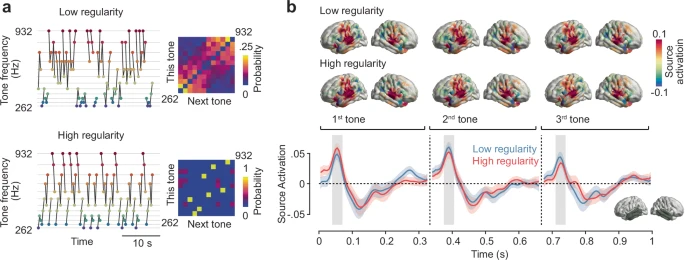Predictive learning shapes the geometry of the human brain

Subjects passively listened to two sequences of 12 acoustic tones.
- a left: exemplary sections of low and high regularity sequences arranged by their frequency. Grey lines indicate triplets. Right: transition matrices of subsequent tones for both sequences.
- b
top: cortical distribution of evoked activity 50–70 ms post onset of each of the three tones in a triplet.
Bottom: source-reconstructed evoked activity in bilateral temporal cortices (bottom right inset) across triplets in the low and high regularity condition. Shaded areas indicate the standard error of the mean (SEM).
Discussion
Our results provide insights into how prediction error signals shape the representational geometry of the human brain. Specifically, our findings show a representational shift across time, through which sensory representations of contiguous and predictable tones became more similar. This effect is commonly referred to as chunking 51. Our results accord well with a large number of studies that provided indirect evidence for chunking22,38,52,53,54,55,56,57
In line with previous work20,30,32, our results revealed changes in the representational geometry consistent with chunking in both sensory and high-level brain regions. This suggests distinct computational systems across the cortical hierarchy tracking sensory statistics in parallel, possibly coordinated by hippocampal activity32,58. Notably, the temporally resolved RSA also allowed us to track the representational dynamics on a fast timescale for each tone presentation. This revealed an early latency of the chunking effect around 120 ms post-tone-onset, which temporally overlaps with the peak pitch representation. This suggests that once representational changes are established, they do not require further top-down modulation59.
Similar to the neural processing sequences shown here, also the dynamics of deep neural networks display a chunking effect during training when gradient-based methods guide them in classification tasks60,61. Initially random in high-dimensional space, the hidden layers’ representations become organised to distinguish class instances effectively through learning. This process mirrors the brain’s processing strategy and suggests shared computational principles between natural and artificial systems62,63,64. Moreover, both systems might cluster similar sensory data to optimise energy use, adhering to environmental and computational limits, thus minimising extraneous exploration of the sensory state space in favour of more streamlined information processing65,66,67,68.
22
Neuroscience/Computational/A Hierarchy of Responses to Auditory Regularities in the Macaque Brain
source: https://www.nature.com/articles/s41467-024-54032-4
#predictiveCoding #auditory #regularity #learning #geometry #sound